Are you a Quiet Speculation member?
If not, now is a perfect time to join up! Our powerful tools, breaking-news analysis, and exclusive Discord channel will make sure you stay up to date and ahead of the curve.
Well, this is rather unfortunate. I was intending to start building a new metagame dataset with SCG Baltimore this week. However, COVID-19 has led to basically everything for the next month being cancelled. Which means I'll need to rely on online data for the foreseeable future. The problem is there isn't enough non-League data to draw any meaningful conclusions. Therefore, this week, I'll be covering something I've had on the back burner for some time: how to beat Jund.

A few weeks ago, I wrote a tech piece about sideboarding against the then-top decks. However, despite calling it out as a top deck, I didn't discuss Jund. Jund's not like most decks in that sideboard cards aren't exactly the key to gaining an edge in the matchup. The key to beating Jund is to know how Jund has Junded its way through Modern and Magic to become the deck players think about when talking midrange decks.
For those new around here, The Beginner's Guide is my article series on the fundamental principles of Modern. Three years ago, I covered playing against fair decks, holding up Jund as a paragon of fairness. However, I only obliquely discussed it. Today, I am going in depth on how Jund leverages its fairness into victory. To be clear, though, this isn't intended as a guide to playing Jund, because I'm not Reid Duke. Instead, this article is about how to avoid just getting Junded out.
What is "Junding Them Out"?
I've thrown around the phrase "Jund them out" a lot over the years. Nobody's ever questioned me about it, nor have I ever questioned it myself. It's one of those things that just makes sense. We've all played against Jund, and had that feeling of games slipping away as Jund just does its thing. It just feels like A Thing which has always been A Thing and we all kind of know what's going on, despite a lack of explicit explanation.
That's fine in everyday life, but not here on Modern Nexus, so I did some digging. It turns out that the origin is actually the Friday Nights YouTube series. For those who can't watch the whole video, in the words of the phrase's originator, "Junding someone out...it's more a state of mind." He goes on to elaborate,
...the characteristic qualities of the Jund shard is aggro, dome, and value...the quintessence of Junding somebody out is you just get 'em!
...the perfect example of a sick Jund line is cascading a Bloodbraid Elf into Blightning. I mean, you just get 'em. Especially if you blow up their Jace with the Blightning, it's just off to the shower room.
The discussion goes on to discuss the fact that Junding is more a philosophy based around being the better attrition deck. Jund's not about anything else, really. It's all about getting the better of the opponent at every step of the game and constantly piling on the value until the opponent is out of the game.
While I would contest some of the details (Bloodbraid into Blightning was a blowout back then), the principle does stand. Junding someone out is to simply dominate the game. There's plenty of Magic being played, but one player is clearly pulling ahead. It's not so much that they have more cards, are ahead on board, or are winning a race. But they are ahead.
How Jund Wins
To put it more analytically, Jund is an attrition strategy. It is designed to trade cards in such a way that it always comes out ahead. Actual two-for-ones or card advantage can be part of that plan, but they're not critical. Jund simply wants to trade advantageously until the game shifts in Jund's favor. Consider this decklist from Regionals:
Jund, Phillip Stanley (SCG Regionals Albany, 1st Place)
Jund has long been characterized as a pile of good cards. Looking at this list, that's an understandable belief. However, it's also an oversimplification. Jund isn't just a pile of good cards, it's a pile of good attrition cards. Jund is a pile of the best interaction, planeswalkers, and creatures at every mana cost. It wants to trade its cards with the opponent's cards, each time ending up better off.
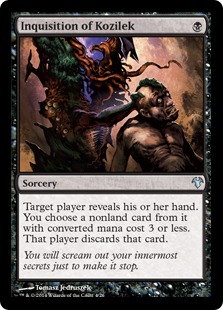 Frequently, it isn't obvious how Jund's winning each exchange, because the trades are one-for-ones. When UW Stoneblade counters Primeval Titan with Cryptic Command, the advantage is obvious; Stoneblade traded up on mana, countered the spell, and drew a card. When Jund takes a Path to Exile with Inquisition of Kozilek, the trade is equivalent in every way. Except that it wasn't. Jund was advancing its gameplan while making its opponent's just a little bit worse.
Frequently, it isn't obvious how Jund's winning each exchange, because the trades are one-for-ones. When UW Stoneblade counters Primeval Titan with Cryptic Command, the advantage is obvious; Stoneblade traded up on mana, countered the spell, and drew a card. When Jund takes a Path to Exile with Inquisition of Kozilek, the trade is equivalent in every way. Except that it wasn't. Jund was advancing its gameplan while making its opponent's just a little bit worse.
Jund is fine with trading card for card, so long as it's gaining some value every time. It doesn't have to be actual card advantage, or even mana advantage. Jund can gain from trading up in card quality, in strategic utility, in gameplan viability, or just in board positioning. The plan is to trade up until Jund has the last card standing and win.
The Tempo Trap
As a result, trying to fight Jund on the tempo axis is a trap. Jund may not be a tempo deck in the traditional sense, but it mostly plays in that same mana-maximizing space. 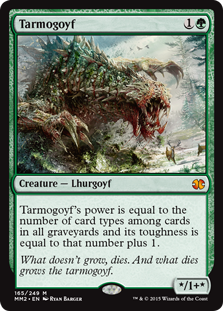 The above Jund list has an average mana cost of 2.14. Part of Jund's advantage is that it maximizes its mana like few decks can, ovrerwhelming the opponent with card quality and efficiency.
The above Jund list has an average mana cost of 2.14. Part of Jund's advantage is that it maximizes its mana like few decks can, ovrerwhelming the opponent with card quality and efficiency.
Jund will use as much of its available mana as possible at every opportunity. However, if it doesn't, that's fine, because it means Jund has more cards down the line to use once there's a need. Jund is fully capable of matching tempo with any deck. So trying to win the tempo game is playing into Jund's gameplan. To beat Jund this way, opponents need to help out by stumbling, or the tempo deck needs to truly dominate the mana game.
Cases in Point
Allow me to demonstrate. I'll take the above example Jund list and draw the following starting hand: Thoughtseize, Inquisition of Kozilek, Lightning Bolt, Tarmogoyf, Blackcleave Cliffs, Overgrown Tomb, Stomping Ground. I will play three turns against two tempo-centric decks: Humans and Mono-Red Prowess. Jund will play second and draw the same three cards (Raging Ravine, Abrupt Decay, Wrenn and Six). I'm also going to Inquisition turn one every time. We'll then consider the relative positions of all three decks at the end of the three turns.
Humans
Humans Turn 1: Play Cavern of Souls naming human, cast Ignoble Hierarch.
Jund Turn 1: Play Blackcleave Cliffs, Inquisition seeing Thalia, Guardian of Thraben, Thalia's Lieutenant, Mantis Rider, Reflector Mage, Horizon Canopy; take Rider.
Humans Turn 2: Play Canopy, cast Thalia with Canopy, attack for 1. (19, 19)
Jund Turn 2: Shock in Overgrown Tomb, Bolt Thalia. (19, 17)
Humans Turn 3: Play Thalia's Lieutenant, attack for 2. (18, 15)
Jund Turn 3: Shock in Stomping Ground, Thoughtseize seeing another Lieutenant and two Mages. Take Lieutenant, cast Wrenn, and downtick to kill Lieutenant. (18, 11)
Prowess
Prowess Turn 1: Play Mountian, cast Soul-Scar Mage.
Jund Turn 1: Play Blackcleave Cliffs, Inquisition seeing Swiftspear, Soul-Scar Mage, Manamorphose, Burst Lightning, Lava Dart; take Swiftspear.
Prowess Turn 2: Play Mage, attack for 1. (20, 19)
Jund Turn 2: Shock in Tomb, Bolt a Mage, Thoughtseize seeing another Manamorphose and take it. (20, 17)
Prowess Turn 3: Play Mountain, cast Manamorphose, cast Swiftspear, cast Dart, attack for 5 (20, 11).
Jund Turn 3: Play tapped Ravine, hold up Decay.
While Jund has a much lower life total against Humans, it is in a far better position to win the game. The worst that can happen is a topdecked Mantis Rider, which Jund will Decay the following turn. Humans will likely have to attack Wrenn, buying Jund an 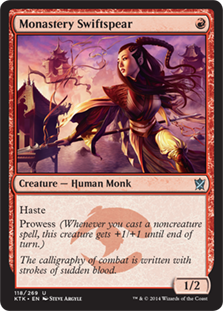 additional turn. It's not a great position since Tarmogoyf is contained by the Mages, but Jund still has the Decay to hold the line a few more draw steps until more removal or creatures arrive.
additional turn. It's not a great position since Tarmogoyf is contained by the Mages, but Jund still has the Decay to hold the line a few more draw steps until more removal or creatures arrive.
Meanwhile, Jund could just die to Prowess in a turn. Prowess will have two creatures to attack with, and with Burst Lightning in hand and Dart in the graveyard. There's a minimum of 6 damage coming Jund's way. After Decaying Mage, Jund's only relevant spell is Tarmogoyf. Given the likelihood of Prowess drawing more spells, Jund has to topdeck very well or it will lose.
Both tempo decks are using their mana to their best ability, but Humans is losing because Jund is matching its tempo by keeping up with card deployment. Prowess is casting more cards than Jund, and has pulled ahead.
To Survive, Thrive
The real key to defeating Jund is not to try and outpace it. Jund's the best at what it does. The longstanding strategy has been to vastly overpower Jund, which is why Tron has always been a good deck. However, that level of going over the top isn't available to most decks. For everyone who isn't Tron, the key is to outlast Jund.
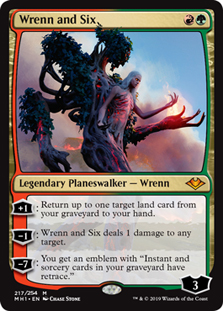 Again, consider the example list. Jund's plan is to win once everyone's hand is exhausted. The only means it has to actually draw extra cards going long is to recur Barren Moor or Nurtured Peatland with Wrenn and Six, which is fairly slow, and in the case of Peatland a tempo hole. Bloodbraid Elf, Kolaghan's Command, and arguably Kroxa are all two-for-ones, but they're the equivalent of a burst of nitrous into the engine rather than a fuel refill. It's the price Jund has paid in dropping Dark Confidant for the more versatile and robust Wrenn.
Again, consider the example list. Jund's plan is to win once everyone's hand is exhausted. The only means it has to actually draw extra cards going long is to recur Barren Moor or Nurtured Peatland with Wrenn and Six, which is fairly slow, and in the case of Peatland a tempo hole. Bloodbraid Elf, Kolaghan's Command, and arguably Kroxa are all two-for-ones, but they're the equivalent of a burst of nitrous into the engine rather than a fuel refill. It's the price Jund has paid in dropping Dark Confidant for the more versatile and robust Wrenn.
Therefore, the best way to beat Jund is to just not lose to attrition. Which I realize sounds incredibly tautological, but it's true. Jund can absolutely shred an opening hand with discard, removal, and Liliana of the Veil; what it can't really protect against is the opponent topdecking their way out. This is the crux of Jund's weakness against combo: Jund can absolutely prevent the initial combo attempt, but its clock is pretty slow. 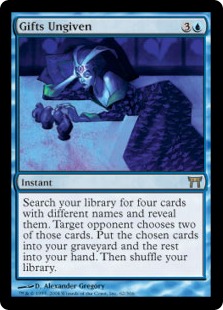 This gives combo the time to draw more cards and reassemble.
This gives combo the time to draw more cards and reassemble.
Alternatively, Jund can just lose to itself. It has a lot of cards, but many are contextual. Discard is great early, dead late. It also has a lot of lands. Despite appearances, Jund often loses topdeck wars to drawing irrelevant lands and spells. This means that resilient decks that never have dead cards can beat Jund at its own game.
On paper, Humans should never beat Jund. Jund's a pile of removal and everything is smaller than Tarmogoyf. In practice, the matchup is fairly close, as Humans is so threat-dense that Jund is never really out of the woods. In my above thought experiment, Jund was definitely ahead, but not out of the woods, because it can't stabilize with Tarmogoyf thanks to Reflector Mage. This is also why Burn is a very tricky matchup. Jund can easily overcome Burn's starting hand, but it's never safe from Burn just drawing and casting Bolts every turn.
Card Advantage
Deck resilience is good, but it pays to weight the proverbial scales. A deck might not be particularly dense on paper, but drawing lots of extra cards can make it so. The most obvious and proven way to combat Jund is simply to swamp it with card advantage. This was where a lot 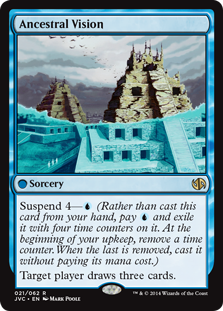 of the hype around Ancestral Vision getting unbanned was headed. Suspend Vision turn 1, get hit by Jund's discard for four turns, then refill after Jund has used up its resources. Any card that provides a steady stream of cards is going to eventually snow Jund under.
of the hype around Ancestral Vision getting unbanned was headed. Suspend Vision turn 1, get hit by Jund's discard for four turns, then refill after Jund has used up its resources. Any card that provides a steady stream of cards is going to eventually snow Jund under.
I have seen Jund successfully grind its opponent down to no cards and no board, only to lose the game by having nothing to follow up. A few weeks ago I was at a Modern cash tournament and watched as a Jund deck, up multiple threats (including Kroxa) and cards against Bant Snow just lose to Uro, Titan of Nature's Wrath recursion because Jund couldn't dig for Scavenging Ooze. Jund's attrition plan cannot survive in the face of extra resources. At that point, it has to rely on raw card power, which is not its chief strength.
Virtual Card Advantage
Actually drawing cards in sufficient quantity isn't necessary, or even available for most decks. What is available to everyone is virtual card advantage. I'm not sure what the right word to describe Jund is, because linear has the right sentiment but wrong connotations while straightforward isn't accurate. Jund's primary line of attack is targeted discard, while its value engine and clock is heavily dependent on its graveyard. Attacking either can simply gut Jund's gameplan by rendering most of Jund's cards dead. An attrition deck with dead cards is doomed.
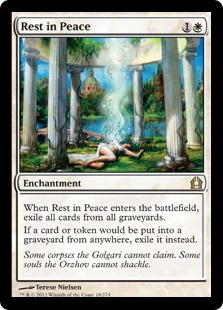 Jund may not be a true graveyard deck in the way that Dredge is, but it really needs a graveyard for many of its cards to be good. Against Rest in Peace, Tarmogoyf is just a 0/1, Ooze is a 2/2, Kroxa is a bad Raven's Crime, and Wrenn can only downtick for any value. Sure, Jund can Trophy Rest and rebuild from there, but it will have expended resources to do so, and it's not like Jund can instantly refill that graveyard. Besides, Jund may be unable to remove the Rest because it can't afford to use the removal spell on the enchantment. By squeezing Jund strategically, decks generate a lot of virtual card advantage, which swallows up Jund's value generation engine.
Jund may not be a true graveyard deck in the way that Dredge is, but it really needs a graveyard for many of its cards to be good. Against Rest in Peace, Tarmogoyf is just a 0/1, Ooze is a 2/2, Kroxa is a bad Raven's Crime, and Wrenn can only downtick for any value. Sure, Jund can Trophy Rest and rebuild from there, but it will have expended resources to do so, and it's not like Jund can instantly refill that graveyard. Besides, Jund may be unable to remove the Rest because it can't afford to use the removal spell on the enchantment. By squeezing Jund strategically, decks generate a lot of virtual card advantage, which swallows up Jund's value generation engine.
Similarly, Leyline of Sanctity is very strong against Jund, if somewhat inconsistent. It doesn't impact the board, but it leaves Jund's main disruption useless. Discard has no target, Liliana can't downtick, and suddenly Jund can't meaningfully interact. Unable to do that, Jund must act as a straightforward beat down deck with removal and while Tarmogoyf's a legendary card, it can't do everything on its own.
Counterboard
The final option is to plan ahead and anticipate Jund. Jund's a very well known deck at this point. Players should know their own decks and where they're weak. Therefore, they should know what cards Jund is going to have and how Jund will sideboard in the matchup, and subsequently how to correctly counterboard. Even in bad matchups, knowing how Jund will attack and preparing against that attack can tip the scales.
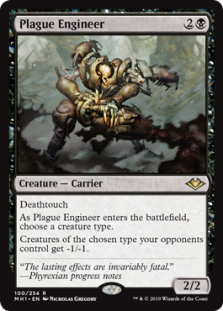 For example, playing Humans against Jund, I know that post-board Jund will have more cheap removal and more importantly Plague Engineer, but at this point sweepers are very rare. So I will take out my very easily Wrenned-to-death Thalias and Phantasmal Images in favor of more robust creatures and Dismembers. The plan: endure Jund's removal, build a board even under Engineer, and win through Jund's attack.
For example, playing Humans against Jund, I know that post-board Jund will have more cheap removal and more importantly Plague Engineer, but at this point sweepers are very rare. So I will take out my very easily Wrenned-to-death Thalias and Phantasmal Images in favor of more robust creatures and Dismembers. The plan: endure Jund's removal, build a board even under Engineer, and win through Jund's attack.
The fact that my example Jund list runs Breeches, Eager Pillager in its sideboard demonstrates the power of counterboarding. Mono-Green Tron and Amulet Titan are very hard matchups for Jund, and so Jund has always sidboarded heavily against them. Jund's typical strategy was to run Fulminator Mage and recur it with Kolaghan's Command, backed up with Alpine Moon or Damping Sphere. Tron and Titan were running Veil of Summer because it's an insane card against counterspells and Jund's discard. However, big mana figured out that Veil is a much bigger blowout against Fulminator Mage, and starting crafting their gameplan accordingly. This very successful counterboard and strategic adaptation has forced Jund to abandon the old plan and move towards Breeches, Eager Pillager to get around Veil.
To Jund or Not To Jund
Jund is a fixture in Modern, so it's time for players to actually understand how the deck works. As it is very hard to overcome Jund with tempo, it is critical to go for the value. Swamping Jund with more cards is great if the option is available, but any kind of card advantage works. Don't try and beat Jund at its own game; Jund's too good at that game. Instead, make the plan work against Jund.




So you’re telling me that Kira and Master of Waves are decent again. I’m picking up what you’re laying down….Fish for life.
On a tangentially related tribal note, Unsettled Mariner in conjunction with consistent pressure and a some interaction in the form of counters or removal have really been a great play for tribal decks like ours to go. I’ve always thought that New Jund (sans Dark Confidant) tends to stumble badly if players counter or remove a timely spell. Your article confirmed that belief for me. So if we set the targets of Meddling Mage, Spell Quellers, and Deprive to Plague Engineer and stomp the gas pedal we can certainly hold our own. Just watch out for the old school Damnation. Also, how do you treat Aether Vial in games two and three? Traditional wisdom has always held that Vials should come out, but with the increased pace of Jund thanks to Kroxa should we be leaving them (or one) in?
Here’s to all the Plague Engineers in the world suddenly getting lost.
Cheers.
I mean, my plan against Jund when I was a fisherman was to land as many Adepts and Spreading Seas as possible, then use Kira and Master to close. So yeah, I guess.
These days, Mariner is so much better curvewise (and it’s stackable) that it’s my plan when I’m on Spirits. I was also always a lot more worried about discard than removal running Spirits for the reasons you mention.
As for Vial, it depends. For Spirits it’s a card you shave (though leave in 1 on the draw, 2 on the play) but Humans I leave them all in. Partially that’s because of mana considerations, but it’s also because Humans needs every opportunity to just get value, and sometimes you get lucky Vialing in something to save a Lieutenant or Champion from Wrenn or Bolt. Also, I run Charming Prince and Vial’s the only way to really use the flicker ability.